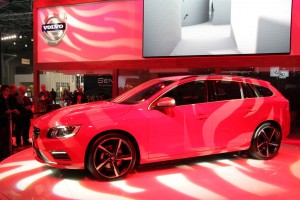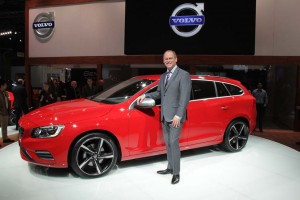Volvo has had a habit of doing things its own way, which includes selling wagons when those so-called two-box designs didn’t work for just about anyone else.
Even Volvo has had to accept market trends in recent years, and shift to more contemporary crossovers. But with the launch of the sporty new V60 R-Design, Swedish brand is hoping to make wagons, well, almost sexy.
Making its debut at the New York Auto Show, the V60-R isn’t the sort of wood-covered wagon one might have expected from decades past. The show car has a fire red paint job covering its almost coupe-like roofline and long, aggressive nose. But what could provide particular appeal is what’s under the hood, a 329-horsepower version of Volvo’s 3.0-liter turbocharged six-cylinder engine.
The V60 is one of three models to get the R-Design treatment, which means a 15 mm lower chassis, increased spring stiffness, a strut brace, stiffer bushings and rear monotube dampers. It also adopts a Corner Traction Control system that directs torque to the outer wheels to improve steering through sharp turns.
The exterior gets distinctive touches such as the high-gloss black stripes on the matte black grille, modified front wheel arches and a unique rear diffuser with aero fins.
All versions of the new V60, meanwhile, feature an almost coupe-like roofline that might surprise those familiar with the squared-off Volvo wagons of decades past.
Inside, the V60 R-Design gets unique sport seats blending perforated leather and nubuck textile material. The R-Design logo is embroidered into the seats. There’s also a distinctive three-spoke sport wheel.
“Volvo has the heritage, unlike any other company, when it comes to wagons,” which makes it possible to sell a vehicle like the V60 in a market that rarely still embraces wagons, said Doug Speck, the maker’s marketing vice president.
The sporty R-Design treatment should also help, he quickly added. The V60-R will launch from 0 to 60 in just 6.0 seconds, a tenth of a second slower than S60 R-Design and two-tenths quicker than the XC60 R-Design crossover.
For those who don’t need quite the performance, Volvo also plans to offer the plain V60 with two alternate powertrains: a 255-hp turbo-five and a 304-hp turbo-six.



Volvo’s issues aren’t the two-box wagon design per se.
Their vehicle styling has always been less than attractive no matter what model. Wagons can be attractive and functional as Audi, VW, BMW and others have shown. Making the Volvo more sporting will sell a few more cars but I highly doubt it will change most consumers POV that volvo styling isn’t all that desirable. With all of the choices available, few people desire to buy an ugly vehicle to help Volvo sales.
The “almost couple like” roof line actually helps aero by reducing the drag caused by the vacuum behind all flat rear vehicles. There are very real drawbacks to these lower, sloping roof designs be they on sedans or wagons.
In sedans you end up with both the front and rear seat occupants smacking their heads into the roof everytime they enter or exist the vehicle. On a wagon which by design is intended to haul larger cargo, the lower rear hatch opening defeats the main purpose for buying a wagon – to be able to load taller items via the hatch.